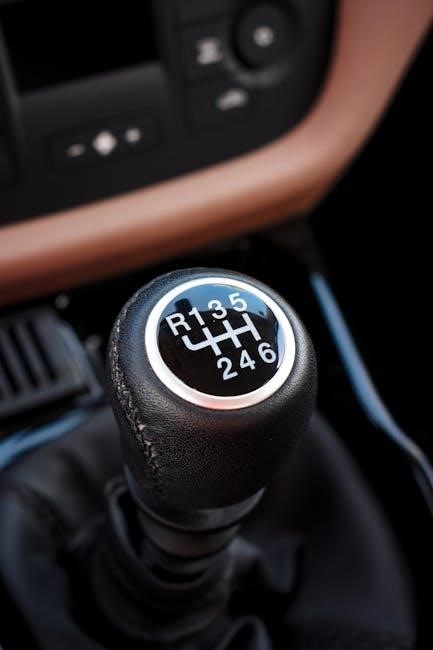
A manual transmission slipping out of gear is a common issue that can occur due to wear and tear or mechanical failure. This problem often leads to unexpected gear disengagement, making driving unpredictable and potentially dangerous.
Understanding the root cause is crucial for proper repairs. Whether it’s a worn clutch, faulty synchronizers, or low fluid levels, addressing the issue promptly ensures safety and maintains your vehicle’s performance. This guide explores these causes and solutions in detail.

Causes of a Manual Transmission Slipping Out of Gear
A slipping manual transmission often stems from a worn-out clutch, which fails to engage gears properly. Broken gear linkages, faulty synchronizers, or low transmission fluid can also cause gears to disengage unexpectedly, leading to loss of control while driving.
Worn-Out Clutch
A worn-out clutch is one of the most common reasons for a manual transmission slipping out of gear. Over time, the clutch disc and pressure plate wear down, reducing the friction needed to engage gears properly. This wear can cause the clutch to fail to hold the connection between the engine and the transmission, leading to unexpected disengagement while driving.
Symptoms of a worn clutch include a soft or spongy clutch pedal, difficulty shifting gears, and a burning smell when driving. If the clutch is severely worn, the transmission may slip out of gear, especially when accelerating or decelerating. This issue is more prevalent in vehicles with high mileage or those that have undergone heavy use.
A worn-out clutch requires prompt attention to prevent further damage to the transmission. Replacing the clutch kit, which includes the clutch disc, pressure plate, and release bearing, is typically the recommended solution. However, it’s important to inspect other components, such as the flywheel, for damage during the replacement process.
Broken Gear Linkage
A broken gear linkage is another common cause of a manual transmission slipping out of gear. The gear linkage connects the gear lever to the transmission, enabling smooth shifting between gears. Over time, the linkage can wear out, especially the nylon or plastic components that connect the lever to the transmission.
Symptoms of a broken gear linkage include gears popping out unexpectedly, difficulty engaging gears, and a loose or unstable gear lever. This issue can occur due to excessive wear, improper installation, or physical damage to the linkage. If left unaddressed, it can lead to further damage to the transmission and make driving unsafe.
A broken gear linkage often requires professional attention to replace the damaged parts. While temporary fixes, such as lubricating the linkage, may provide some relief, they are not a permanent solution. Addressing this issue promptly is crucial to ensure smooth gear engagement and prevent more severe transmission problems down the line.
Faulty Synchronizers
Faulty synchronizers are a common cause of a manual transmission slipping out of gear. Synchronizers are critical components that ensure smooth shifting by equalizing the speed of the gear and the shaft before engagement. When they become worn or damaged, gears may not fully engage, leading to unexpected slippage.
Symptoms of faulty synchronizers include grinding noises during shifting, difficulty engaging gears, and the transmission popping out of gear while driving. This issue often occurs in higher gears, such as third, fourth, or fifth, where synchronizer wear is more pronounced due to increased stress.
Faulty synchronizers can result from excessive wear, improper shifting habits, or lack of maintenance. While replacing the clutch kit may sometimes resolve related issues, synchronizer problems typically require professional mechanical attention. Addressing this issue promptly is essential to prevent further damage to the transmission and ensure reliable performance.
Low Transmission Fluid
Low transmission fluid levels are a frequent cause of a manual transmission slipping out of gear. Transmission fluid plays a vital role in lubricating gears, reducing friction, and maintaining hydraulic pressure necessary for smooth operation. When fluid levels drop, the system cannot function properly, leading to gears disengaging unexpectedly.
Symptoms of low transmission fluid include difficulty shifting gears, unusual noises, and the transmission slipping into neutral without warning. This issue is often exacerbated by driving conditions that generate heat, as fluid levels may decrease further due to evaporation or leaks. If left unaddressed, low fluid levels can cause irreversible damage to the transmission.
Regular fluid checks and timely refills are essential to prevent this problem. Using the correct type of transmission fluid is equally important, as specified in the vehicle’s manual. If slipping persists after refilling, it may indicate a more serious issue, such as internal component failure, requiring professional inspection and repair. Proper fluid maintenance is key to ensuring the longevity and performance of a manual transmission.

Symptoms of a Faulty Manual Transmission

Common symptoms include gears popping out unexpectedly, difficulty engaging gears, and unusual noises. These issues often indicate underlying problems like worn components or low fluid levels, requiring immediate attention to prevent further damage and ensure safe driving.
Gears Popping Out Unexpectedly
Gears popping out unexpectedly is a common symptom of a manual transmission issue. This occurs when the transmission slips out of gear while driving, often due to worn or damaged components such as the clutch, synchronizers, or gear linkages.
When this happens, the car may suddenly drop into neutral, causing a loss of power and control. This can be particularly dangerous at high speeds or in heavy traffic. Drivers often report that the gearshift moves freely or feels loose, indicating a potential problem with the gear linkage or selector mechanism.
In some cases, the issue may be intermittent, happening only under specific conditions such as acceleration or deceleration. However, it can quickly escalate into a more serious problem if left unaddressed. Identifying the root cause, whether it’s a faulty pilot bearing, worn-out clutch, or broken gear teeth, is essential for a proper repair.
Regular maintenance and inspection of the transmission components can help prevent this issue from arising. If gears continue to pop out unexpectedly, it is crucial to seek professional assistance to ensure the vehicle remains safe and reliable to drive.

Difficulty Engaging Gears
Difficulty engaging gears is a common issue in manual transmissions that can make driving frustrating and unsafe. This problem often manifests as a hesitation or resistance when attempting to shift into a specific gear, such as first gear when starting from a standstill or higher gears during acceleration.
This issue can arise from several causes, including a worn-out clutch, low transmission fluid levels, or faulty synchronizers. A worn clutch may fail to engage properly, preventing the gear from locking in securely. Similarly, insufficient transmission fluid can reduce hydraulic pressure, making it harder for gears to engage smoothly.
Faulty synchronizers are another common culprit. Synchronizers are responsible for ensuring gears align properly before engaging. If they become damaged or worn, they may struggle to mesh gears effectively, leading to difficulty when shifting.
In some cases, the gear linkage or selector fork may be misaligned or damaged, causing gears to only partially engage. This can result in a “grinding” sensation or the gear slipping out shortly after engagement.
Addressing the issue promptly is crucial to avoid further damage to the transmission. Regular maintenance, such as checking transmission fluid levels and inspecting the clutch and gear components, can help prevent or identify these problems early on.

Unusual Noises
Unusual noises are a common symptom of a manual transmission that is slipping out of gear. These noises can vary in nature, ranging from grinding sounds when shifting to clunking or clicking noises while driving.

One of the most frequent noises associated with this issue is a grinding sound, which typically occurs when gears are not properly aligned before being engaged. This can be caused by worn-out synchronizers, which are responsible for ensuring gears mesh smoothly during shifting. If the synchronizers are damaged, they may fail to align the gears correctly, leading to a grinding noise.
Additionally, a clunking or clicking sound may be heard when the transmission slips out of gear. This noise is often due to the gear disengaging abruptly, causing a sudden shift in the transmission’s mechanical components. In some cases, a worn-out pilot bearing or damaged gear teeth can also produce these noises.
It is important to address unusual noises promptly, as they can indicate more serious underlying issues. Ignoring these sounds may lead to further damage to the transmission, resulting in costly repairs. Regular maintenance and inspections can help identify and resolve these problems before they escalate.